YEAR FIVE OVERVIEW
We successfully delivered over 10,892 tCO2e of carbon reductions in Year 5 of our Net Zero Routemap (2024/25), through a range of activities such as peatland restoration and energy projects.
These also delivered cost savings, improved source water quality in three catchments, increased biodiversity/natural capital across 858 hectares (ha) (equivalent to over 1,000 football pitches), and improved our resilience to a changing climate and energy security risks.
Our reported annual operational greenhouse gas emissions – our total carbon footprint over the year – reduced by 4,546 tCO2e to 220,434 tCO2e. This compares to 224,980 tCO2e last year. This reduction was achieved through reduced energy demand alongside our carbon reduction energy efficiency measures and increased on-site renewable energy production. Changes to the emission factors for grid electricity increased over the past year, increasing our footprint by 202 tCO2e.
Our carbon reduction activities are vital as a changing climate is threatening our ability to deliver essential water and waste water services. We must therefore adapt our approaches and do everything possible to minimise the carbon emissions associated with our activities and maximise the positive contribution we can make.
We continued to make progress across all areas of our routemap and delivered actions which eliminated, reduced or captured emissions.
Highlights include:
We continue to review our progress and learn from our experiences.
We have recognised that we need to expand our knowledge and capabilities around the installation of process emission monitors in our activated sludge waste water sites and their data connectivity with our existing digital systems. We have increased our resourcing in this area and have on-boarded a further company to help support monitor installation.
To reinforce the management, continuous improvement and learning required to embed net zero across all we do, we have worked towards successful accreditation this year with the PAS2080 (Publicly Available Specification) for carbon management.
We completed a review of our supply chain for hydrotreated vegetable oil (HVO). HVO is now being used to support carbon emission reductions in the parts of our fleet that are currently unsuitable for EVs due to load or distance factors. The HVO we use is certified as not containing virgin palm oil. Following our review and on-going scrutiny of our supply chain we have no evidence to suggest that virgin palm oil has been used.
To address modern slavery concerns in solar panel materials we have now established an ethical supply chain for solar panels. However, it is taking time to implement and this may mean reductions in our planned renewable programme for the rest of this regulatory period.
Whilst it was a record year for peatland restoration, several projects could not be completed due to challenges around gaining support from landowners/tenants in our water catchments.
We can only achieve our Beyond Net Zero ambition by working in partnership and we are continuing to strengthen and expand our activities in this area.
Our 10 year land management plan for Loch Katrine with Forestry and Land Scotland (FLS) was approved by Scottish Forestry (SF) in 2024. This supports the capture of up to 1 million tCO2e over the next 60 years by creating and regenerating 4,380 ha of woodland and restoring up to 400 ha of peatland. FLS are now underway with 24 ha woodland planted and over 90 ha of land reached sufficient maturity and density through natural regeneration to be re-classified as native woodland this year. We also restored 55 ha of peatland and working with the Hydro Nation Chair installed innovative peatland restoration monitoring. Loch Katrine Research – Scottish Water
Our partnership with the Royal Botanic Garden Edinburgh on their ‘plants with purpose’ programme is progressing well and our PhD student has now been appointed. They are examining and optimising planting schemes to support carbon reduction in blue-green infrastructure projects such as rain gardens and storm water planters.
In 2024/25, we completed three woodland creation projects in East Renfrewshire and South Lanarkshire (Dunside Water Treatment Works, Glengavel Reservoir and Newton Mearns Waste Water Treatment Works), planting a total of 41 ha within the Clyde Climate Forest. This builds on the 19 ha of woodland already created adjacent to the Clyde Climate Forest boundary. In 2025/26 we have three woodland creation projects planned in the Forth Climate Forest area.
Hydrogen will be an important fuel in the wider Net Zero transition, and water is a key component in the production of hydrogen. To support the growing hydrogen economy, Scottish Water Horizons is working with stakeholders and production companies on over 80 projects across the country with a potential hydrogen capacity of over 7 GW. To provide the most sustainable and economic input source, and to conserve water supplies within the catchment, our preferred water source for hydrogen production is final effluent from our waste water treatment works.
In our commitment to partnership Scottish Water continues to work with the Edinburgh and Glasgow Climate Compact to help to boost climate action.
And our Low Carbon Concrete Collective (LCC) with Network Rail, SSE, Scottish Power and Transport Scotland is continuing to make progress. The Collective was established in 2022 to accelerate the development, availability and adoption of the next-generation of low carbon concrete in Scotland and are progressing the design and pilot of:
We are also progressing with the Advanced Market Commitment for low carbon concrete with Innovate UK.










If you would be interested in partnering with us for example to:
Please contact our Net Zero lead Elise Cartmell.
To encourage knowledge sharing, our Net Zero Heroes network continue to go from strength to strength. We now have approaching 100 people meeting together regularly from Scottish Water and our supply chain partners to share best practice. It includes people who have enabled and implemented carbon savings and carbon capture opportunities and others who have improved Net Zero reporting or delivered an exemplary project to help us with our sustainability ambitions. We have also initiated work with some of our key equipment suppliers to better understand how their products will decarbonise over time. This has allowed us to update our pathway to Net Zero investment emissions.
We are starting to link in with community groups with woodland planting. We have completed planting days with Friends of the Pentlands at Glencorse successfully planting around 400 native broadleaf samplings and at Roscobie Reservoir with local communities and the Fife Coast and Countryside Trust (FCCT) to plant around 1,600 silver birch, downy birch, oak, elder, hawthorn and crab apple tree saplings across a 1.4 ha area surrounding the reservoir.
Team Effort for Trees at Glencorse – Scottish Water
Volunteers Dig In to Create Native Woodland at Roscobie Reservoir – Scottish Water
We and our partners have been externally recognised for our work receiving three awards in 2024/25.
ICE Scotland Sustainability Champion Award – Ian Watt

Built Environment Smarter Transformation Ross Shire Enginering – Gamechanger Award, Timber Modular Build
WGMB and Scottish Water – Circular Economy MEICA Strategy for Utility Assets – Utility Week Awards 2024
We continued to make progress across all areas of our routemap and delivered actions which eliminated, reduced or captured emissions.
Highlights include:
We continue to review our progress and learn from our experiences.
We have recognised that we need to expand our knowledge and capabilities around the installation of process emission monitors in our activated sludge waste water sites and their data connectivity with our existing digital systems. We have increased our resourcing in this area and have on-boarded a further company to help support monitor installation.
To reinforce the management, continuous improvement and learning required to embed net zero across all we do, we have worked towards successful accreditation this year with the PAS2080 (Publicly Available Specification) for carbon management.
We completed a review of our supply chain for hydrotreated vegetable oil (HVO). HVO is now being used to support carbon emission reductions in the parts of our fleet that are currently unsuitable for EVs due to load or distance factors. The HVO we use is certified as not containing virgin palm oil. Following our review and on-going scrutiny of our supply chain we have no evidence to suggest that virgin palm oil has been used.
To address modern slavery concerns in solar panel materials we have now established an ethical supply chain for solar panels. However, it is taking time to implement and this may mean reductions in our planned renewable programme for the rest of this regulatory period.
Whilst it was a record year for peatland restoration, several projects could not be completed due to challenges around gaining support from landowners/tenants in our water catchments.
We can only achieve our Beyond Net Zero ambition by working in partnership and we are continuing to strengthen and expand our activities in this area.
Our 10 year land management plan for Loch Katrine with Forestry and Land Scotland (FLS) was approved by Scottish Forestry (SF) in 2024. This supports the capture of up to 1 million tCO2e over the next 60 years by creating and regenerating 4,380 ha of woodland and restoring up to 400 ha of peatland. FLS are now underway with 24 ha woodland planted and over 90 ha of land reached sufficient maturity and density through natural regeneration to be re-classified as native woodland this year. We also restored 55 ha of peatland and working with the Hydro Nation Chair installed innovative peatland restoration monitoring. Loch Katrine Research – Scottish Water
Our partnership with the Royal Botanic Garden Edinburgh on their ‘plants with purpose’ programme is progressing well and our PhD student has now been appointed. They are examining and optimising planting schemes to support carbon reduction in blue-green infrastructure projects such as rain gardens and storm water planters.
In 2024/25, we completed three woodland creation projects in East Renfrewshire and South Lanarkshire (Dunside Water Treatment Works, Glengavel Reservoir and Newton Mearns Waste Water Treatment Works), planting a total of 41 ha within the Clyde Climate Forest. This builds on the 19 ha of woodland already created adjacent to the Clyde Climate Forest boundary. In 2025/26 we have three woodland creation projects planned in the Forth Climate Forest area.
Hydrogen will be an important fuel in the wider Net Zero transition, and water is a key component in the production of hydrogen. To support the growing hydrogen economy, Scottish Water Horizons is working with stakeholders and production companies on over 80 projects across the country with a potential hydrogen capacity of over 7 GW. To provide the most sustainable and economic input source, and to conserve water supplies within the catchment, our preferred water source for hydrogen production is final effluent from our waste water treatment works.
In our commitment to partnership Scottish Water continues to work with the Edinburgh and Glasgow Climate Compact to help to boost climate action.
And our Low Carbon Concrete Collective (LCC) with Network Rail, SSE, Scottish Power and Transport Scotland is continuing to make progress. The Collective was established in 2022 to accelerate the development, availability and adoption of the next-generation of low carbon concrete in Scotland and are progressing the design and pilot of:
We are also progressing with the Advanced Market Commitment for low carbon concrete with Innovate UK.











If you would be interested in partnering with us for example to:
Please contact our Net Zero lead Elise Cartmell.
To encourage knowledge sharing, our Net Zero Heroes network continue to go from strength to strength. We now have approaching 100 people meeting together regularly from Scottish Water and our supply chain partners to share best practice. It includes people who have enabled and implemented carbon savings and carbon capture opportunities and others who have improved Net Zero reporting or delivered an exemplary project to help us with our sustainability ambitions. We have also initiated work with some of our key equipment suppliers to better understand how their products will decarbonise over time. This has allowed us to update our pathway to Net Zero investment emissions.
We are starting to link in with community groups with woodland planting. We have completed planting days with Friends of the Pentlands at Glencorse successfully planting around 400 native broadleaf samplings and at Roscobie Reservoir with local communities and the Fife Coast and Countryside Trust (FCCT) to plant around 1,600 silver birch, downy birch, oak, elder, hawthorn and crab apple tree saplings across a 1.4 ha area surrounding the reservoir.
Team Effort for Trees at Glencorse – Scottish Water
Volunteers Dig In to Create Native Woodland at Roscobie Reservoir – Scottish Water
We and our partners have been externally recognised for our work receiving three awards in 2024/25.

ICE Scotland Sustainability Champion Award – Ian Watt

Built Environment Smarter Transformation Ross Shire Enginering – Gamechanger Award, Timber Modular Build

WGMB and Scottish Water – Circular Economy MEICA Strategy for Utility Assets – Utility Week Awards 2024
PROGRESS IN YEAR
During 2024/25 we made good progress across all four key strategic activity areas of our routemap:
BECOMING MORE
ENERGY EFFICIENT
Saved 6.28 GWh of electricity in our water and waste water services through over 50 energy efficiency projects through pump refurbishment, variable speed drive (VSD) installations, air source heat pumps and LED lighting projects. The installation of air source heat pumps has also reduced the requirement for heating oil.
Saved 4.08 GWh at our waste water treatment works, 0.84 GWh at our waste water sludge pumping stations and 1.36 GWh at our water treatment works.
Completed 16 renewable energy projects with a generating capacity of 6.42 GWh.
Installed a European first 0.82 GWh siphon hydro energy scheme at Whiteadder Reservoir in East Lothian.
USING LOWER-CARBON
ENERGY PRODUCTS
Added a further 79 electric vehicles to our fleet giving us 540 in total and expanded our number of charging points to 374.
Deployed sustainable hydro-treated vegetable oil (HVO), which has c. 90% lower carbon emissions compared to diesel, with our investment programme partners and within our Scottish Water fleet and standby generators.
Used recycled aggregate material in excavations and service reservoir overburden.
Implemented our low carbon kiosk framework with Ross Shire Engineering, Quinnshield and Capvond with 15 orders of wood kiosks already placed.
embracing low
carbon construction
Adopted low carbon steel reinforcement (Rebar) products with c. 50% lower CO2e content. Approximately 12% of our construction emissions are associated with Rebar products and therefore a reduction of 5-6% of our total construction emissions is now possible.
Continued with our low carbon concrete pilots producing a pre-cast low carbon concrete manhole ring, a structural foundation and a pre-cast cable trough using a ground granulated blast-furnace slag (GGBS) blend with Recycl8’s bottom ash aggregate using landfill waste. This embraces the circular economy alongside carbon reduction.
Completed a Research and Innovation project on a pump refurbishment trial with WGM, installing 29 refurbished pumps and saving c. 68tCO2e and c. £129,000.
storing away emissions that
cannot be avoided
Restored a record 555 ha of peatland in our water catchments.
Planted 208 ha of native broadleaf woodland with oak, alder, hawthorn, rowan and birch trees.
Confirmed the establishment of 95 ha of natural woodland regeneration at Loch Katrine and other sites.
These activities also improve source water quality and biodiversity and support our catchments becoming more resilient to climate change impacts.
KEY FUTURE OBJECTIVES
FOR YEAR 6 AND YEAR 7 APRIL 2025 – MARCH 2027
Years 6 and 7 in our routemap bring us to the end of our current regulatory period Strategic Review of Charges 2021 – 2027 (SRC21). Our plan is to continue our delivery focus on carbon reductions and to prepare activities for our next regulatory period Strategic Review of Charges 2027 – 2033 (SRC27).
In particular we will:
FOR OUR NEXT REGULATORY PERIOD 2027-2033
We will act across all key strategic goals in our routemap to:
Minimise Operational Emissions
Minimise Investment Emissions
Increase Carbon Capture on our land
2024/25 OPERATIONAL EMISSIONS FOOTPRINT
GREENHOUSE GAS EMISSIONS BY SOURCE
Our operational greenhouse gas emissions – our carbon footprint – were 220,434 tCO2e. This compares with 224,980 tCO2e last year.
This significant reduction was achieved due to reduced energy demand alongside energy efficiency measures and increased on-site renewable energy production. Changes to the emission factors for grid electricity increased the impact of our activities by 202 tCO2e.
Our actions are resulting in a continued downward trend for our operational emissions, and we remain on track to deliver net zero before 2040.
To do this we need to progress hosted wind farms on our land, invest in new technology to replace ageing sludge drying facilities and for the electricity grid to decarbonise. These, along with current intelligence on progress of process emissions reductions and forecast increase in carbon capture on our land show that we should achieve operational Net Zero in the mid-2030s.
As in previous years the footprint was successfully verified externally to ISO 14064-1.
The continued greening of the grid coupled with increased energy efficiency and renewables delivery has made a significant contribution to our progress, but at 56% of emissions, electricity remains our biggest source.
At 23%, process emissions from waste water treatment are the next biggest source, which is driving much of the focus on innovation and research to minimise these emissions in the future.
PROGRESS UPDATE
We have highlighted key milestones on the way to net zero in our routemap which covers all aspects of our emissions. Our milestones are supported by a range of actions and activities to build capacity and capability which we undertake to deliver specific goals over defined timescales to reach net zero.
Progress across our goals can be viewed in the sections below.
Electricity consumption is still our largest single source of emissions at 56%. We must reduce our consumption to reduce emissions and increase financial benefits, while enabling us to support other goals such as generating all the electricity we consume.
GOAL: 20% reduction by 2040
GOAL: 100% of energy used is our own or hosted renewables by 2040
Process emissions, particularly nitrous oxide (N2O) remain the most challenging area for the water sector to address, requiring a focus on the science, measurement and management of emissions, as well as on technologies to reduce or eliminate the production of emissions.
GOAL: 20% reduction by 2040
Philipshill Waste Water Treatment Works (WwTW) – you can’t control what you can’t measure.
Reducing our reliance on fossil fuels across all of our sites is a key part of getting to net zero. This has proven a complex matter as we rely heavily on fuels for emergency and stand-by generators and extreme weather events are becoming more frequent and intense.
38.7 GWh of energy was generated from bioresources in 2024/25 by Scottish Water and PFI partners
GOAL: 100% reduction
Key Achievements:
Our fleet recorded travel of 22 million miles last year delivering service for customers. This is a four million increase on the previous year. The reason for this increase is that we moved to a new telematics supplier and telematics were fitted to all long-term hire vehicles, meaning these numbers were added for the first time.
Our strategy aims to minimise the miles we travel and find zero emissions ways to travel.
GOAL: 50% reduction in the distance we travel
GOAL: 100% Zero Emissions Fleet
We were the first UK water company to include investment emissions as part of our net zero goal. Now that our operational emissions are reducing investment emissions are now our biggest source of emissions each year.
GOAL: 75% reduction in carbon intensity of investment
GOAL: 75% reduction in carbon intensity
Across the 23,500 hectares of our land, we can contribute to the natural, social and economic sustainability of Scotland’s landscape by working to increase carbon storage and biodiversity
GOAL: Improve carbon dioxide storage on our land to support net zero emissions
Electricity consumption is still our largest single source of emissions at 56%. We must reduce our consumption to reduce emissions and increase financial benefits, while enabling us to support other goals such as generating all the electricity we consume.
GOAL: 20% reduction by 2040
GOAL: 100% of energy used is our own or hosted renewables by 2040
Process emissions, particularly nitrous oxide (N2O) remain the most challenging area for the water sector to address, requiring a focus on the science, measurement and management of emissions, as well as on technologies to reduce or eliminate the production of emissions.
GOAL: 20% reduction by 2040
Philipshill Waste Water Treatment Works (WwTW) – you can’t control what you can’t measure.
Reducing our reliance on fossil fuels across all of our sites is a key part of getting to net zero. This has proven a complex matter as we rely heavily on fuels for emergency and stand-by generators and extreme weather events are becoming more frequent and intense.
38.7 GWh of energy was generated from bioresources in 2024/25 by Scottish Water and PFI partners
GOAL: 100% reduction
Key Achievements:
Our fleet recorded travel of 22 million miles last year delivering service for customers. This is a four million increase on the previous year. The reason for this increase is that we moved to a new telematics supplier and telematics were fitted to all long-term hire vehicles, meaning these numbers were added for the first time.
Our strategy aims to minimise the miles we travel and find zero emissions ways to travel.
GOAL: 50% reduction in the distance we travel
GOAL: 100% Zero Emissions Fleet
We were the first UK water company to include investment emissions as part of our net zero goal. Now that our operational emissions are reducing investment emissions are now our biggest source of emissions each year.
GOAL: 75% reduction in carbon intensity of investment
GOAL: 75% reduction in carbon intensity
Across the 23,500 hectares of our land, we can contribute to the natural, social and economic sustainability of Scotland’s landscape by working to increase carbon storage and biodiversity
GOAL: Improve carbon dioxide storage on our land to support net zero emissions
ENABLERS
We cannot achieve our ambitious goals alone and we assume that required future investment funding is available. On our journey to net zero there are some key enabling activities which we have progressed in the last year.
PEOPLE
CUSTOMERS AND COMMUNITIES
GOVERNANCE
POLICY AND REGULATION
PROCUREMENT
INNOVATION
NET ZERO RESEARCH AND INNOVATION
We have progressed a number of activities across these areas, click each icon to read more.
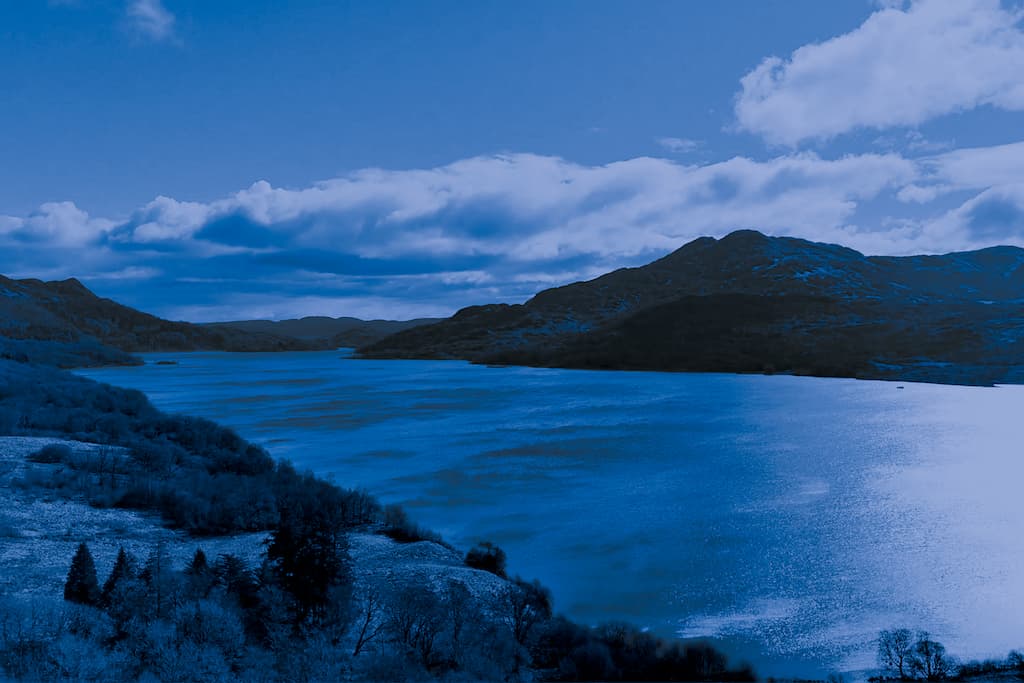
AMMONIA RECOVERY TRIAL
Progression of a 5m3/day ammonia recovery technology has continued with programme and contracts being finalised. Started on site in Autumn 2025.
We will test the Ammonium sulphate liquid produced for all European fertiliser regulation requirements to ensure the quality of the output material meets specifications required and can potentially be reused.
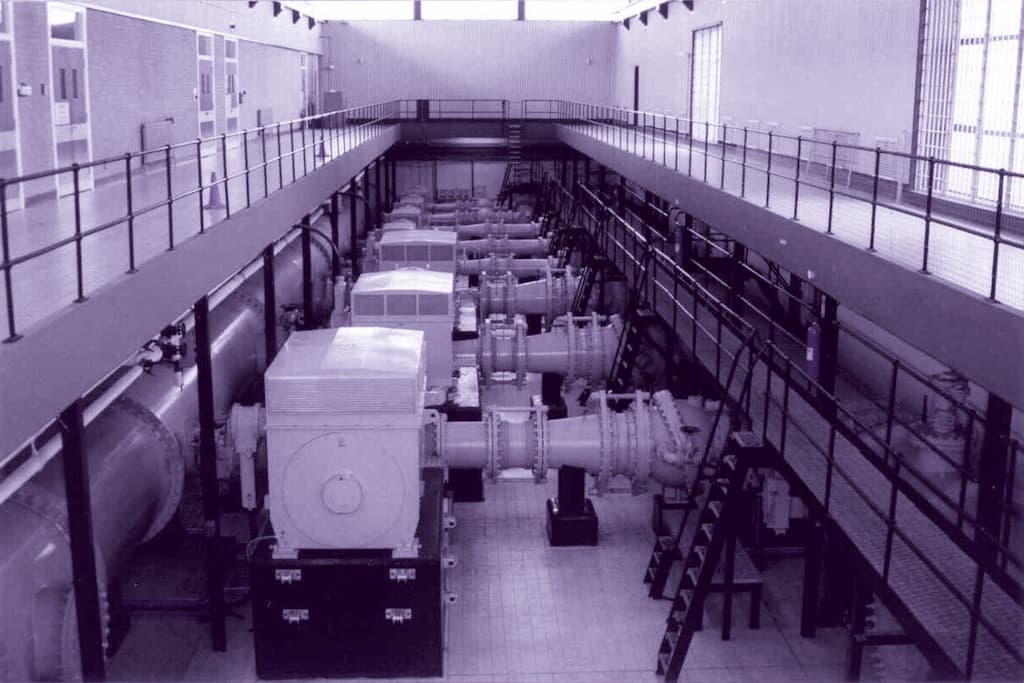
NITROUS OXIDE CAPTURE AND DESTRUCTION TECHNOLOGY
We are planning a trial of an activated sludge plant cover and destruction technology with Powerplastic and Suez. This will utilise an odour control style cover which collects the off gases and then actively blows the gases into a photocatalytic destruction box with tuneable UV and catalyst concentration.
Preliminary designs complete and final designs underway with the potential to capture ? tonnes CO2e.
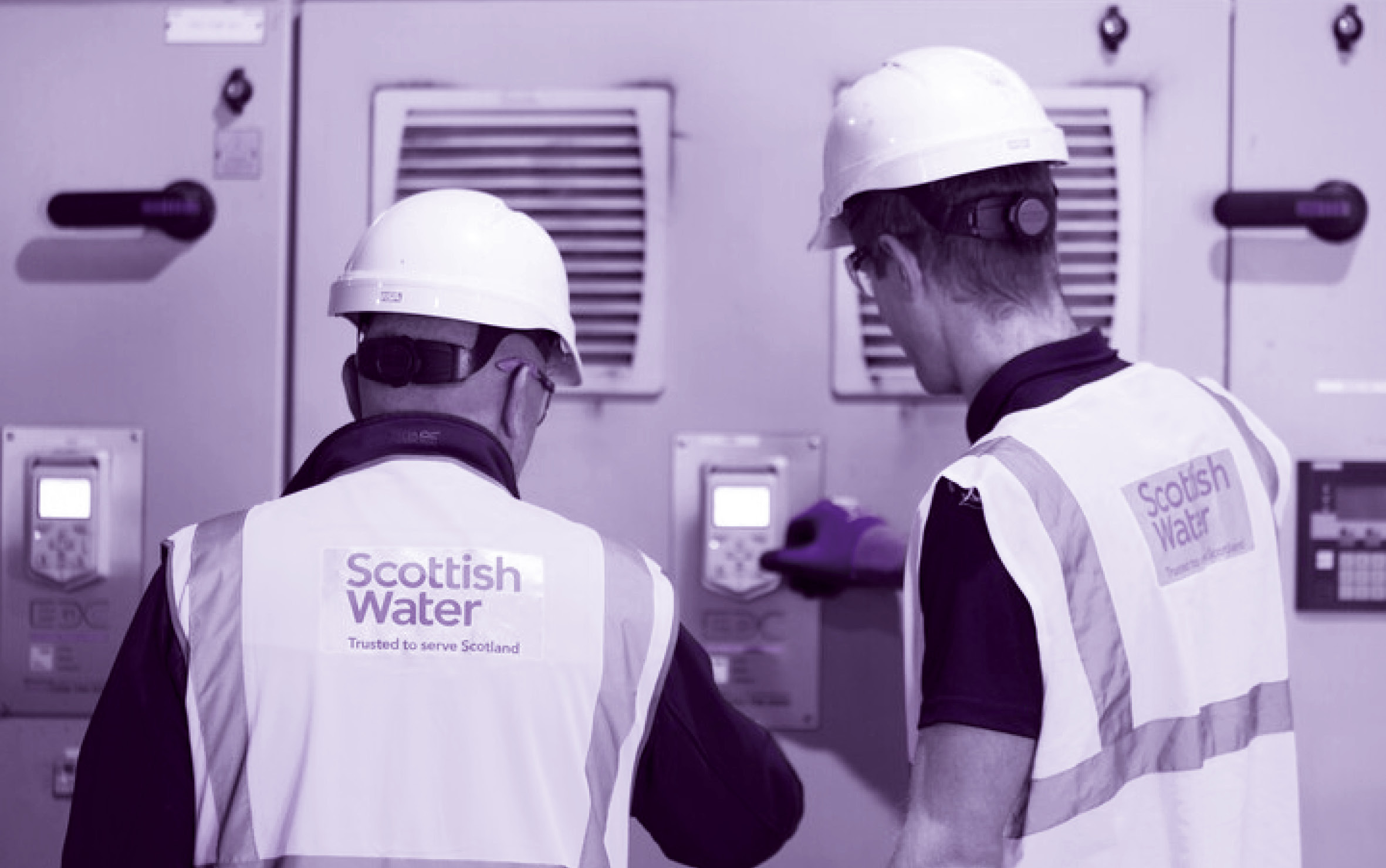
DIGITAL AND ANALYTICAL TOOLS – METHANE MEASUREMENT AND LiDAR
A short scale trial for methane leak identification and whole site quantification has been undertaken utilising QLMs technology on a trailer.
This trial allowed Scottish Water to identify areas for potentially high-level emissions which were in line with assumptions made prior to the trial.
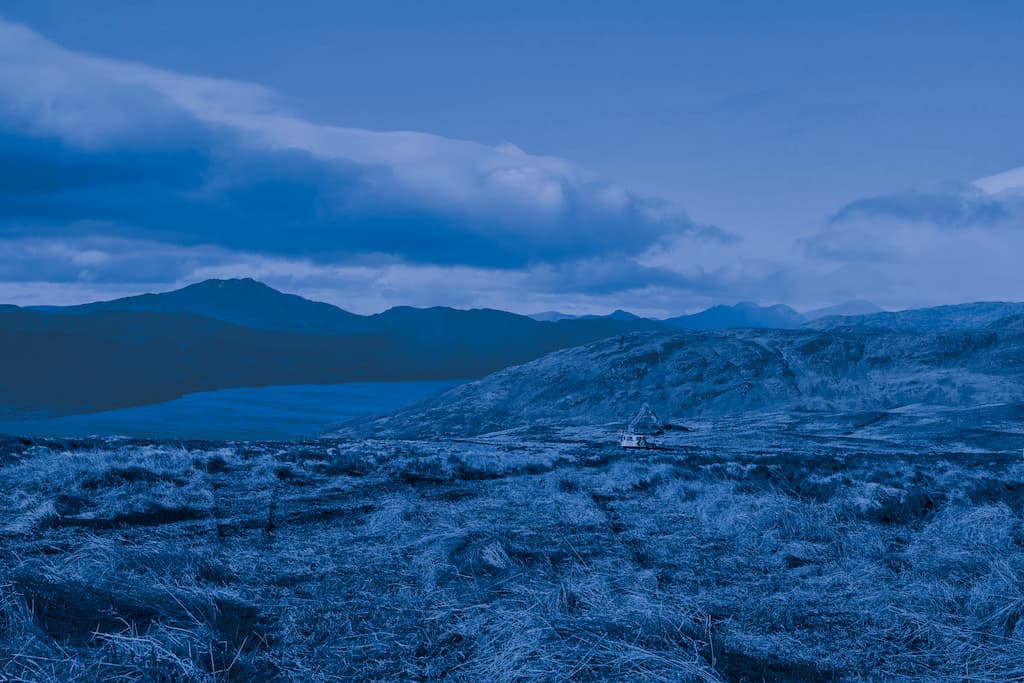
DIGITAL AND ANALYTICAL TOOLS – LiDAR TO EXAMINE NATURAL REGENERATION OF WOODLAND
Completed a LiDAR (Light Detection and Ranging) study with the Hydro Nation Chair to monitor natural regeneration of woodland at Loch Katrine.
This study examined tree cover greater than 1.5m above ground, across > 500 ha of targeted sites in the region of Glen Gyle at the head of Loch Katrine.
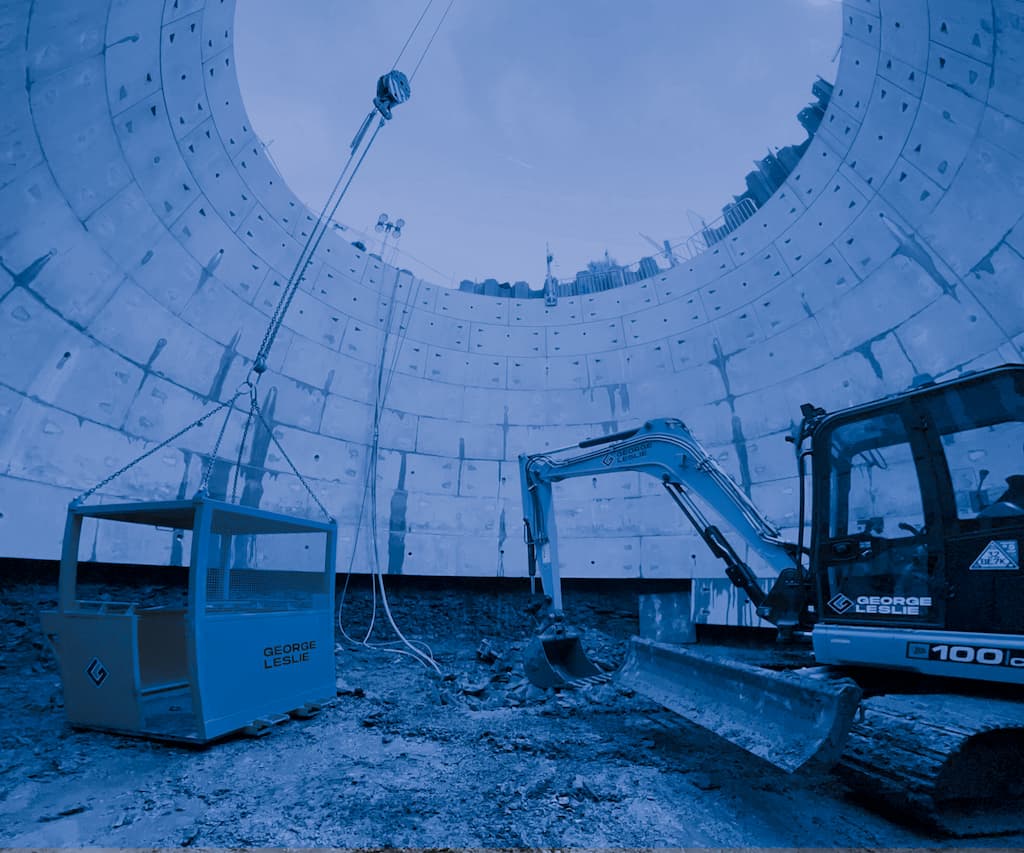
MATERIALS RESEARCH
Concrete Collective (LCC) with Network Rail, SSE, Scottish Power and Transport Scotland is continuing to make progress. The Collective is progressing the design and pilot of new concrete materials including:
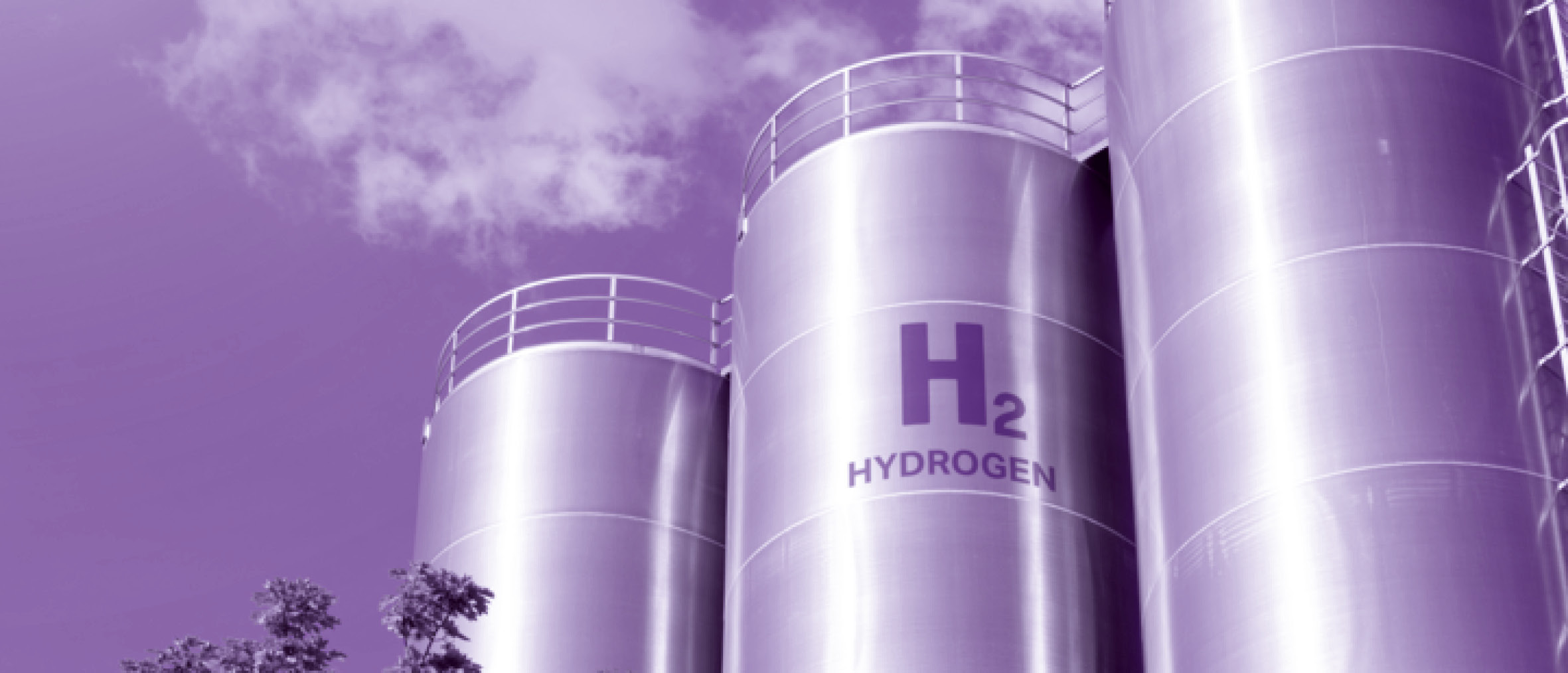
HYDROGEN PRODUCTION
Supported by the Scottish Government, Scottish Water Horizons have been collaborating with the NHS to establish whether waste water heat recovery from Scottish Water’s sewerage network can be utilised to help heat NHS facilities to reduce their carbon footprint. This is showing positive results and work is ongoing to carry out flow and temperature measurements to establish the available energy. One site has progressed to the stage of carrying out a detailed engineering study.
Progression of a 5m3/day ammonia recovery technology has continued with programme and contracts being finalised. Started on site in Autumn 2025.
We will test the Ammonium sulphate liquid produced for all European fertiliser regulation requirements to ensure the quality of the output material meets specifications required and can potentially be reused.
NITROUS OXIDE CAPTURE AND DESTRUCTION TECHNOLOGY
We are planning a trial of an activated sludge plant cover and destruction technology with Powerplastic and Suez. This will utilise an odour control style cover which collects the off gases and then actively blows the gases into a photocatalytic destruction box with tuneable UV and catalyst concentration.
Preliminary designs complete and final designs underway with the potential to capture ? tonnes CO2e.
A short scale trial for methane leak identification and whole site quantification has been undertaken utilising QLMs technology on a trailer.
This trial allowed Scottish Water to identify areas for potentially high-level emissions which were in line with assumptions made prior to the trial.
Completed a LiDAR (Light Detection and Ranging) study with the Hydro Nation Chair to monitor natural regeneration of woodland at Loch Katrine.
This study examined tree cover greater than 1.5m above ground, across > 500 ha of targeted sites in the region of Glen Gyle at the head of Loch Katrine.
Concrete Collective (LCC) with Network Rail, SSE, Scottish Power and Transport Scotland is continuing to make progress. The Collective is progressing the design and pilot of new concrete materials including:
Supported by the Scottish Government, Scottish Water Horizons have been collaborating with the NHS to establish whether waste water heat recovery from Scottish Water’s sewerage network can be utilised to help heat NHS facilities to reduce their carbon footprint. This is showing positive results and work is ongoing to carry out flow and temperature measurements to establish the available energy. One site has progressed to the stage of carrying out a detailed engineering study.
Supported by the Scottish Government, Scottish Water Horizons have been collaborating with the NHS to establish whether waste water heat recovery from Scottish Water’s sewerage network can be utilised to help heat NHS facilities to reduce their carbon footprint. This is showing positive results and work is ongoing to carry out flow and temperature measurements to establish the available energy. One site has progressed to the stage of carrying out a detailed engineering study.
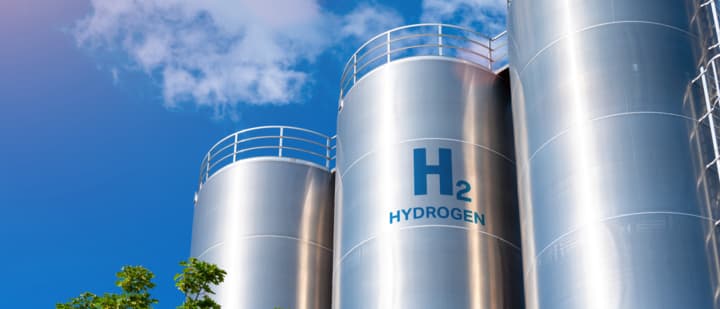
Concrete Collective (LCC) with Network Rail, SSE, Scottish Power and Transport Scotland is continuing to make progress. The Collective is progressing the design and pilot of new concrete materials including:
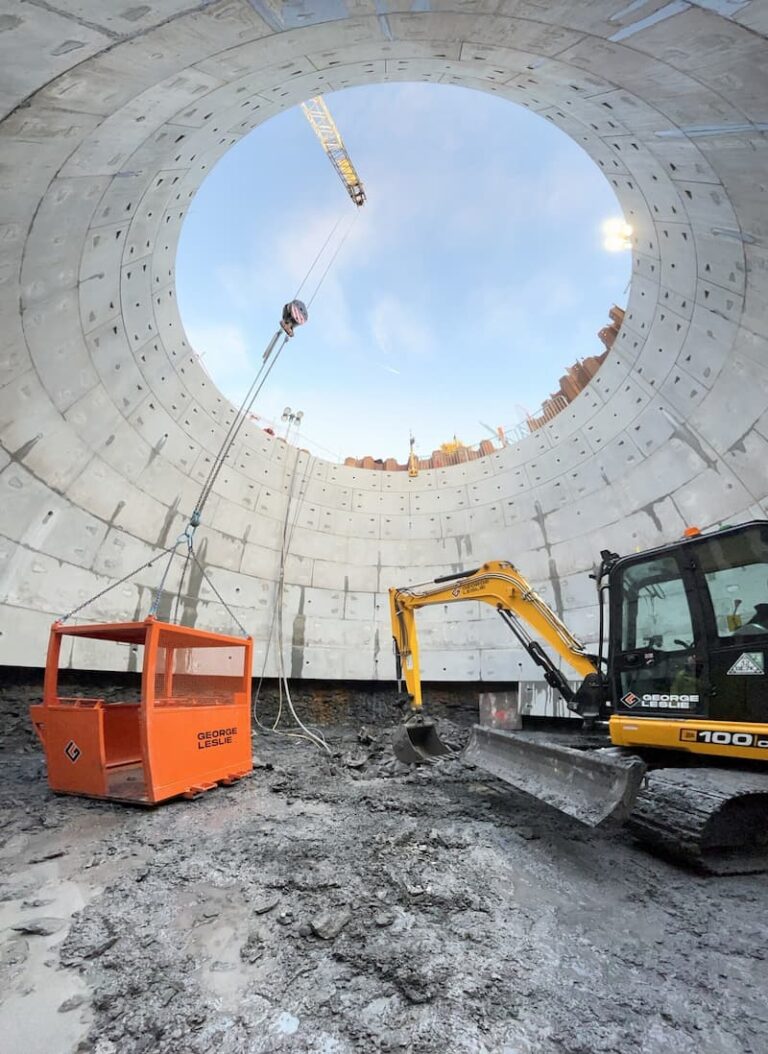
Progression of a 5m3/day ammonia recovery technology has continued with programme and contracts being finalised. Started on site in Autumn 2025.
We will test the Ammonium sulphate liquid produced for all European fertiliser regulation requirements to ensure the quality of the output material meets specifications required and can potentially be reused.
We are planning a trial of an activated sludge plant cover and destruction technology with Powerplastic and Suez. This will utilise an odour control style cover which collects the off gases and then actively blows the gases into a photocatalytic destruction box with tuneable UV and catalyst concentration.
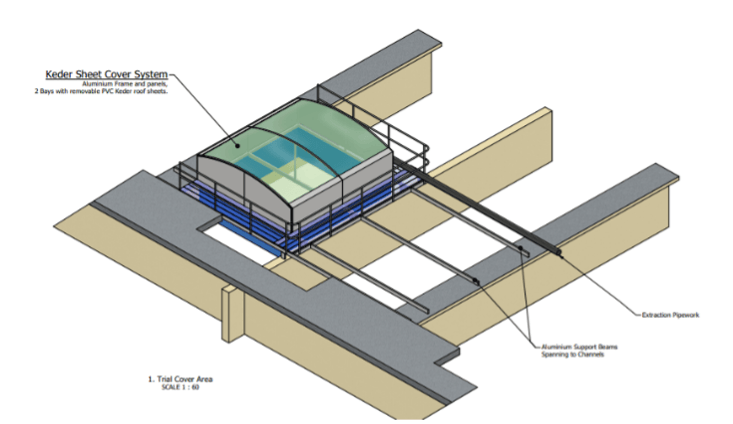
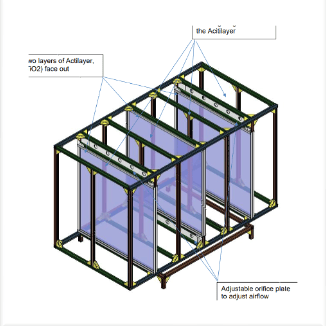
Work has been completed on a £2.3 million solar power and battery energy storage scheme at Howden Water Treatment Works near Selkirk which is set to save around 169 tonnes of carbon annually.
The scheme consists of 2,112 ground-mounted solar panels and 15 racks of batteries to store the power generated – which will meet over a third of the site’s power usage and support Scottish Water’s drive to reach net zero emissions by 2040.
The battery energy storage system, the first of its kind on a Scottish Water water treatment asset and only the second on a Scottish Water site to date, means 100% of the renewable power generated by the scheme can be used on site whenever it is needed.
Recognising the importance of safety in such an innovative project, rigorous measures were implemented including remote fault detection, automatic shutdown systems and fire suppression within the battery cabinets.
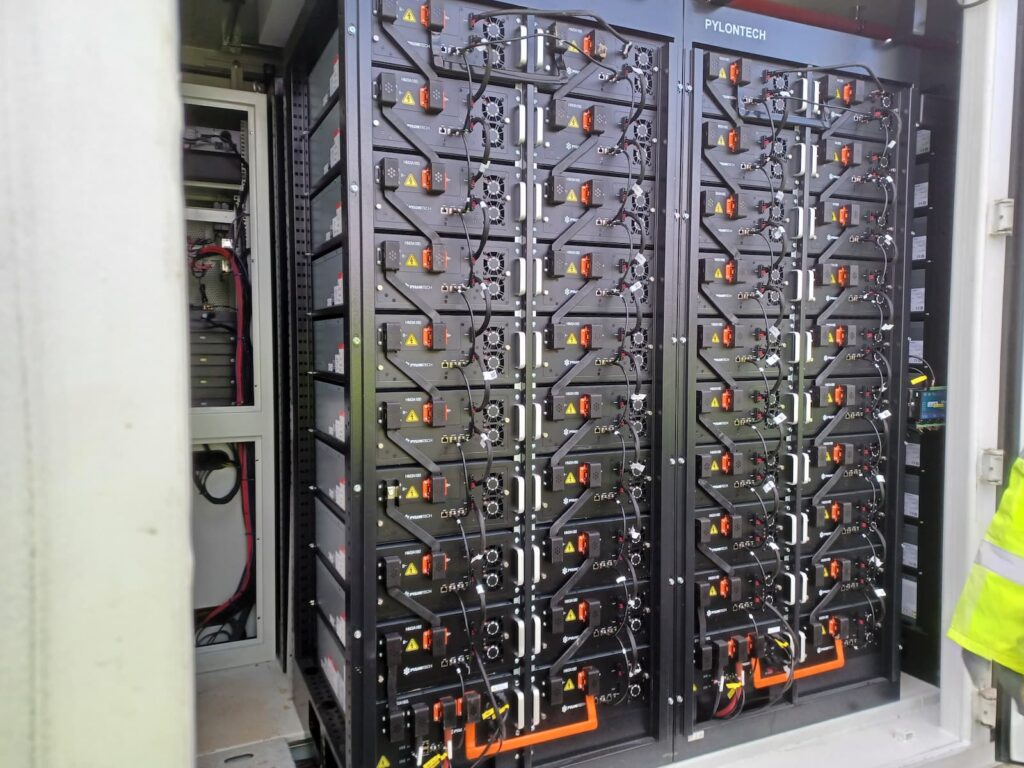
A pioneering new type of hydro energy generation scheme is now in place at Whiteadder Reservoir in East Lothian, believed to be the first of its kind in Europe.
The £3million scheme is expected to offset almost a third of the energy used by one of East Lothian’s largest pumping stations, named Hungry Snout, which takes around 32 million litres of water per day to Castle Moffat Water Treatment Works before it goes on to supply most of the East Lothian region with drinking water.
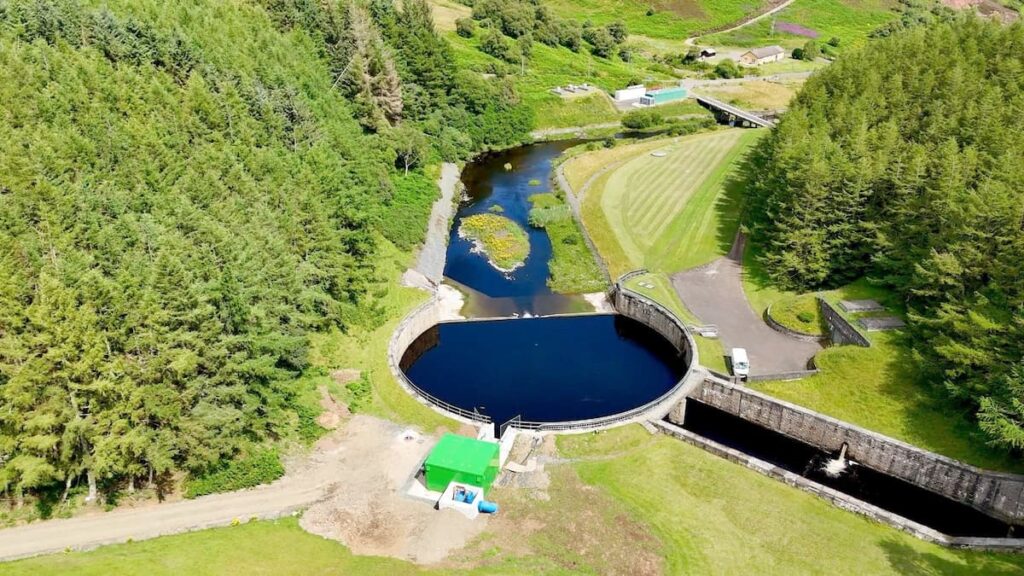
The project allows green energy to be generated whilst also accurately controlling the level of the reservoir during seasonal fluctuations in weather.
Through the use of siphon technology, water is drawn up through the intake and over the top of the dam before running down through the siphon, through the hydro turbine, and back to the natural environment.
The investment at Whiteadder will significantly reduce the carbon emissions from the pumping station, saving approximately 111 tonnes of carbon each year, the equivalent of a passenger jet flying from Edinburgh to Sydney, Australia 40 times.
It is expected to generate 0.82GWh of renewable energy per annum from the 199kW turbine.
The project has been led by Scottish Water Horizons, the public utility’s commercial subsidiary, and delivered by renewable energy specialists Emtec Energy.
A short scale trial for methane leak identification and whole site quantification has been undertaken utilising QLMs technology on a trailer.
This trial allowed Scottish Water to identify areas for potentially high-level emissions which were in line with assumptions made prior to the trial.
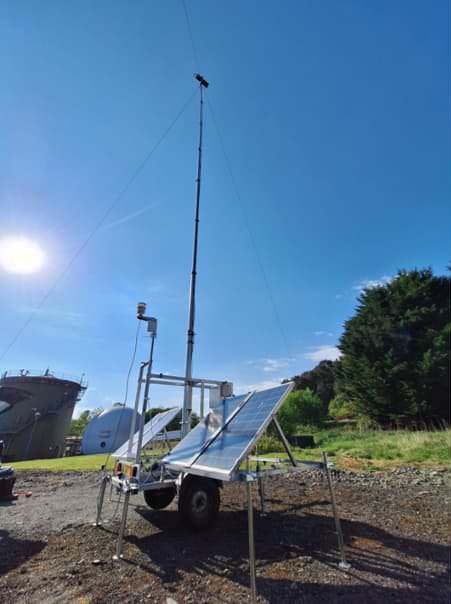
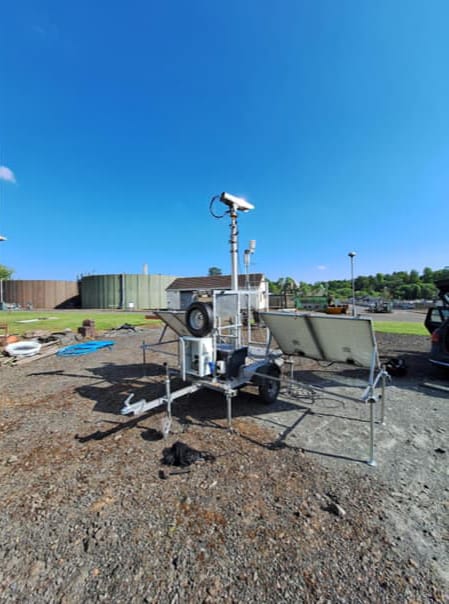
Having visual data showing that uncovered sludge tanks and cake pads are a source of significant CH4 emissions will enable the quick wins to be identified and the emissions mitigated to gain the biggest reductions.
The technique can also be deployed for routine leak detection and repair (LDAR).
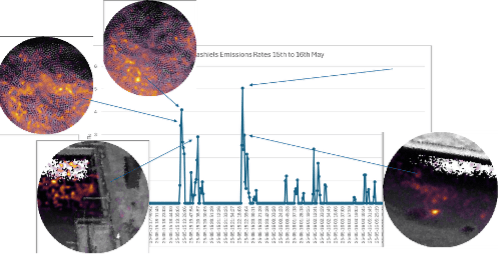
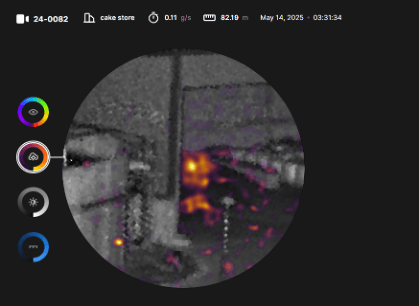
The results have been shared with the teams responsible for industrial emissions compliance and bioresources teams for decision on whether to deploy at bioresource sites.
Completed a LiDAR (Light Detection and Ranging) study with the Hydro Nation Chair to monitor natural regeneration of woodland at Loch Katrine.
This study examined tree cover greater than 1.5m above ground, across > 500 ha of targeted sites in the region of Glen Gyle at the head of Loch Katrine. A novel approach for surveying woodland regeneration, LiDAR creates highly accurate 3D models and maps, enabling detailed analysis of terrain, vegetation, and infrastructure, crucial for applications like autonomous vehicles, environmental monitoring, and infrastructure planning. The aim of this project was to deliver analysis of woodland regeneration along with efficacy testing of the methodology to capture the required density to determine woodland regeneration.
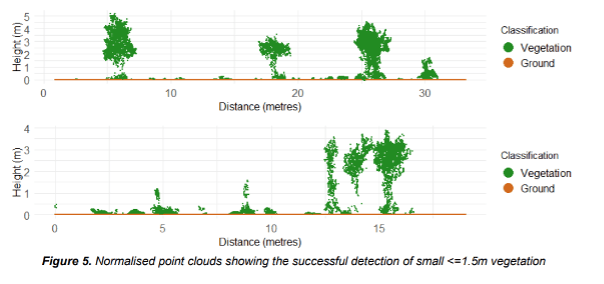
The approach adopted, conducted over 6 days, used a DJI Matrice 350 Unmanned Aerial System with attachable DJI Zenmuse L2 Lidar payload. Flying at 60m-80m above ground, the LIDAR survey yielded a point cloud density of ~500 returns / m2 . Data was processed using DJI Terra 4.4 and the lidR package (4.1.2) of the R language (4.4.2). Maps and spatial analysis were produced using QGIS Desktop 3.34 and ArcGIS Pro 3.1. The resulting point clouds were filtered for noise, normalised and used to produce a Digital Terrain Model (DTM), Digital Surface Model (DSM) and Canopy Height Model (CHM) at 0.5m spatial resolution.
In total, the survey successfully captured low vegetation across 634 ha, with total canopy cover over the survey area found to be 93.2 ha. The data and evidence resulting from the LiDAR surveys demonstrate that the LiDAR methodology is appropriate and effective for monitoring early woodland creation and re-establishment.
Completed a LiDAR (Light Detection and Ranging) study with the Hydro Nation Chair to monitor natural regeneration of woodland at Loch Katrine.
This study examined tree cover greater than 1.5m above ground, across > 500 ha of targeted sites in the region of Glen Gyle at the head of Loch Katrine. A novel approach for surveying woodland regeneration, LiDAR creates highly accurate 3D models and maps, enabling detailed analysis of terrain, vegetation, and infrastructure, crucial for applications like autonomous vehicles, environmental monitoring, and infrastructure planning. The aim of this project was to deliver analysis of woodland regeneration along with efficacy testing of the methodology to capture the required density to determine woodland regeneration.

The approach adopted, conducted over 6 days, used a DJI Matrice 350 Unmanned Aerial System with attachable DJI Zenmuse L2 Lidar payload. Flying at 60m-80m above ground, the LIDAR survey yielded a point cloud density of ~500 returns / m2 . Data was processed using DJI Terra 4.4 and the lidR package (4.1.2) of the R language (4.4.2). Maps and spatial analysis were produced using QGIS Desktop 3.34 and ArcGIS Pro 3.1. The resulting point clouds were filtered for noise, normalised and used to produce a Digital Terrain Model (DTM), Digital Surface Model (DSM) and Canopy Height Model (CHM) at 0.5m spatial resolution.
In total, the survey successfully captured low vegetation across 634 ha, with total canopy cover over the survey area found to be 93.2 ha. The data and evidence resulting from the LiDAR surveys demonstrate that the LiDAR methodology is appropriate and effective for monitoring early woodland creation and re-establishment.
Scottish Water has piloted an innovative approach to woodland creation through the use of fungal pellets with the aim to produce more resilient forests, increase carbon capture potential and reduce the need for fertiliser.
The Rhizopellets have been used on six of its woodland creation sites which were planted over the 2024/25 season and monitoring will be carried out to establish the impact they have on the success of the projects.
The pellets, produced by Edinburgh-based start-up venture Rhizocore Technologies, utilise native mycorrhizal fungi to create a symbiotic underground nutrient network that helps both trees and fungi to flourish.
They are planted alongside the saplings so that the fungi and tree roots can establish a connection, grow together, and the fungi can provide water and nutrients to the tree.
Often, the sites that have been identified for woodland creation have not had trees on them for some time which means the natural mycorrhiza fungi is no longer sufficiently present at these locations.
Kiosks are an essential part of many of our water and wastewater treatment sites and have traditionally been made from glass-reinforced plastic. One of the very first Timber Modular Build (TMB) kiosks, developed and produced by one of our delivery partners, has been delivered to one of Scottish Water’s sites in Howden Wells, near Selkirk. It was manufactured offsite using wood from Scottish Water forestry.
The structure will be used to house chemical dosing equipment needed at the water treatment works and will reduce embodied carbon by up to 75% compared to traditional kiosks made from glass-reinforced plastic. Additionally, it is fully recyclable.
Prior to delivery to the site, the TMBs are fitted out and commissioned, so they are ready to go immediately once taken to the site. The new timber enclosures also exceed fire resistance regulations, will outlast the 25-year design life of a traditional kiosk, and can be constructed more rapidly.
Our partner won the Gamechanger award for the TMB at the Accelerate to Zero Awards, which recognise the businesses, organisations, and individuals making the biggest contribution to decarbonising the built environment.
More info and photos are here: Innovative timber kiosks helping Scottish Water cut carbon on site – Scottish Water
While Scottish Water is working to transition as much of its fleet as possible to electric vehicles, certain segments—such as 4x4s, HGVs, large vans, and high-mileage vehicles—are not yet suitable for electrification due to current technology limitations, vehicle range, or maintenance infrastructure.
To address this gap and reduce emissions in the near term, Hydrotreated Vegetable Oil (HVO) is being trialled as a low-carbon alternative to diesel. To make refuelling as straightforward as possible for drivers, a reliable network of access points across Scotland is required.
Currently, Scottish Water has access to the following public HVO refuelling locations (Blue Tag): Certas Energy sites in Dumfries, Forfar, Ecclefechan and Highland Fuels site in Lerwick. Additional forecourt options are also being explored, including sites operated by Gulf (a Certas brand), to expand coverage and make HVO more accessible.
Access is also available to a partner refuelling site at Clancy’s Livingston location (Red Tag), which is currently being used by a small number of drivers. Working with partners to share infrastructure and improve availability across combined networks will continue to be progressed.
Refuelling capabilities are in the process of being established at key Scottish Water locations, including: Daldowie, Henderson Drive and Juniper House (Yellow Tag). Work is underway to set up the necessary logistics and access at these sites to support internal HVO use and further reduce environmental impact.
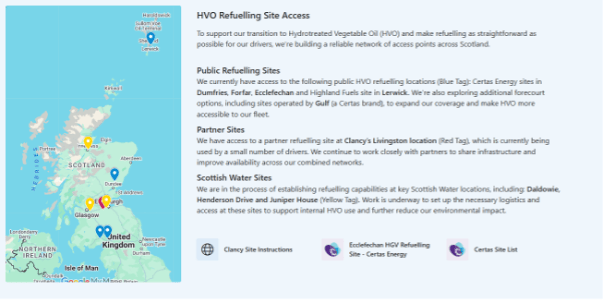
Population Equivalent: 58,834
Type of works: nitrifying activated sludge plant (ASP) using diffused aeration.
Phillipshill is a medium sized waste water treatment works in East Kilbride. Its secondary treatment is split between two phases: Phase A treats 30% of screened sewage and Phase B treats 70% of screened sewage. We are monitoring nitrous oxide (N2O) using liquid phase N2O sensors in both Phase A and Phase B. This allows us to get actual site-wide nitrous oxide emission factors (EF) for reporting rather than using national Carbon Accounting Workbook (CAW) factors. Philipshill is also the first site where we have deployed our flux gas hood monitoring to validate the data we are receiving from the liquid phase probes, ensuring we have reliable data for reporting and to inform our future process emission mitigation actions. We are one of the first water utilities in the UK to deploy gas hoods for process emission validation.
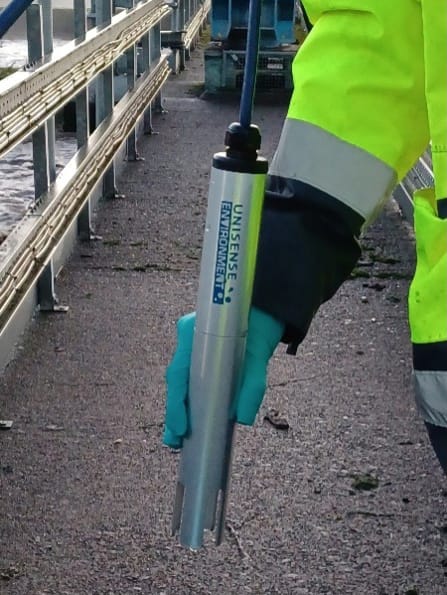
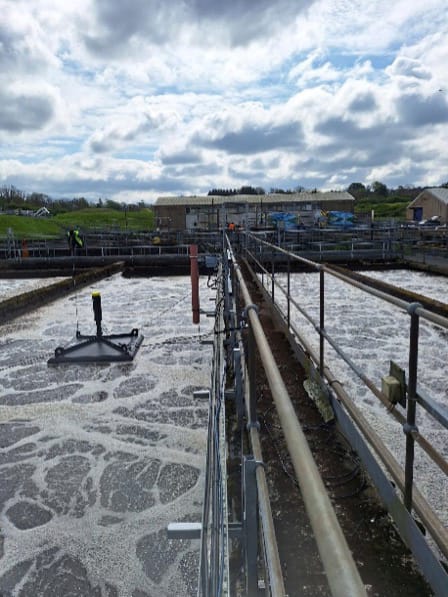
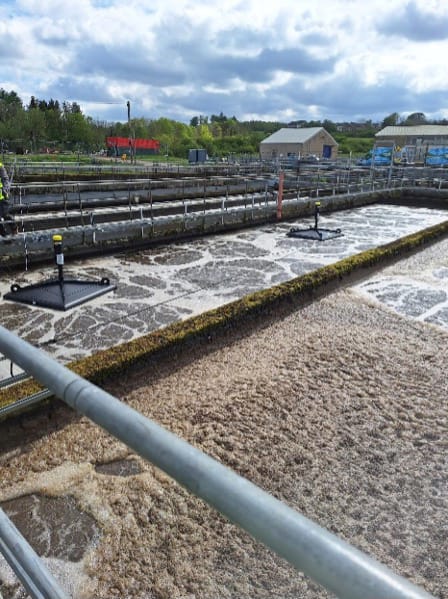
We are now seeing stable monitoring at Philipshill and are able to make some early observations on nitrous oxide at these works whilst we continue to develop more reliable air flow measurement.
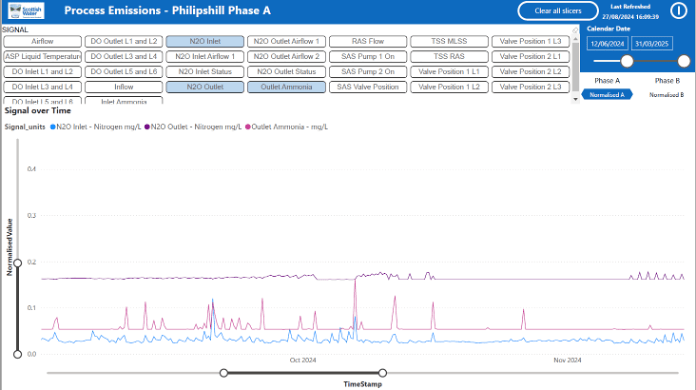

Next steps at Philipshill are to solve our air flow measurement challenges and continue to analyse the data so that informed action can be taken once 12 months of baseline data has been gathered. Interventions will be considered for implementation in 2026. In the meantime, a site emission factor will be calculated and compared to the current Carbon Accounting Workbook figure to allow us to determine if we have been over or under-reporting process emissions at this site.
We have worked with two communities in Prestwick and the Craigleith area of Edinburgh to trial a pilot scheme aimed at providing a natural solution to reduce surface water flooding in the areas. Residents who signed up to take part in the trial have had rainwater planters and water butts installed, capturing rainwater that flows off their roof and preventing it from overwhelming the drainage system during periods of heavy rain.
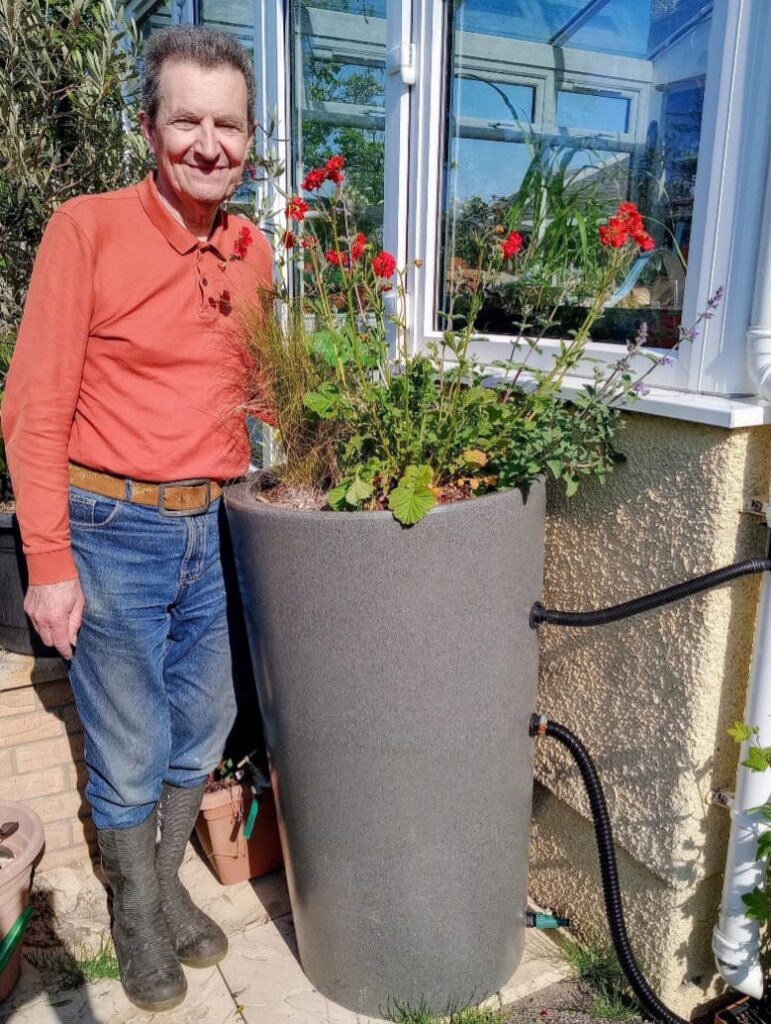
We worked in partnership with a local community group in Aberdeen to provide an improved habitat for wading and farmland birds on Scottish Water land at Inchgarth Reservoir, as well as protecting and enhancing biodiversity at the site.
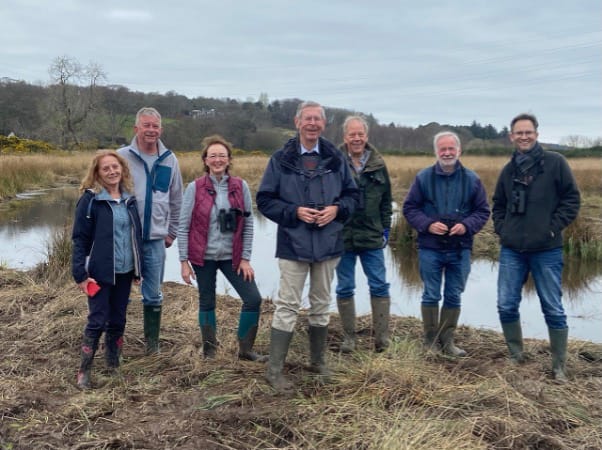
Alongside Inchgarth Biodiversity Initiative (IBI) of Cults, Bieldside and Milltimber Community Council, and contractor Ground Control, two wader scrapes have now been created on grassland at the site – shallow pools of water which provide important feeding sites for adults and chicks of farmland waders such as Snipe and Jack Snipe.
In addition, a 6,941 m2 area has been tilled and planted up with a winter seed crop which will help attract more birds and pollinating insects to the area, while a number of birch trees have also been planted along the perimeter of the site by IBI volunteers.
We helped save the equivalent of more than 70,000 single use bottles thanks to the presence of our Pop Up Taps at the Royal Highland Show in Ingliston, Orkney Island Games and Water Safety Day at Loch Lomond over the summer, where we made fresh drinking water easily accessible to those attending and encouraged the use of refillable bottles.
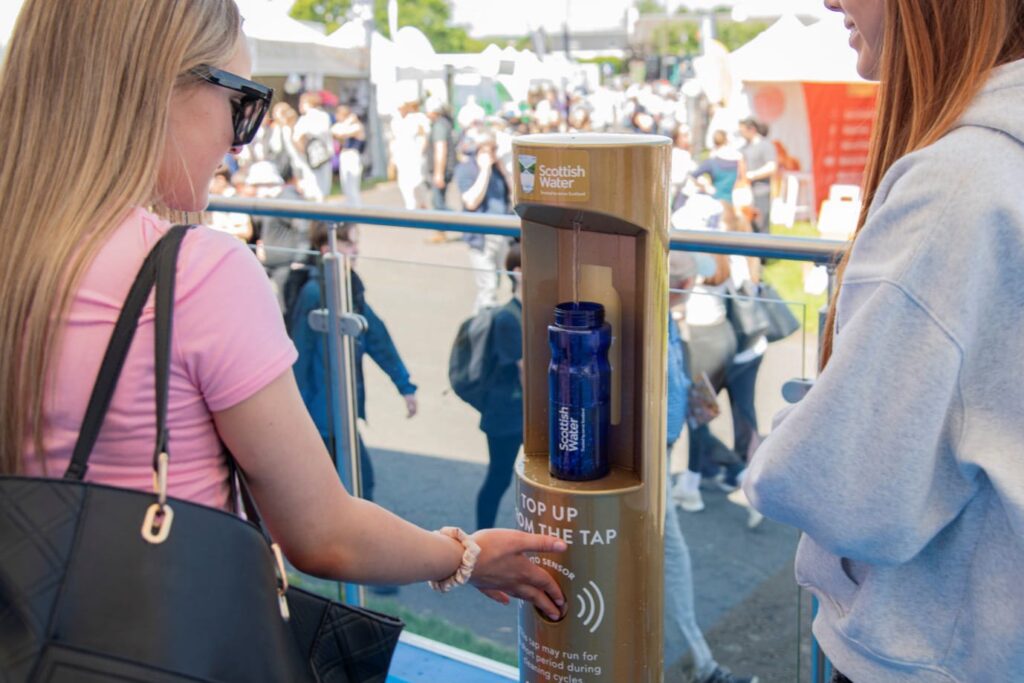
More widely, our permanent network of 132 Top Up Taps has served up the equivalent of over 17 million bottles worth of drinking water to customers around the country.
Through our Generation H20 education programme, we have engaged with over 58,000 young people, 942 teachers and 791 schools to date, aiming to inspire them to become part of a movement to celebrate and protect Scotland’s water and become responsible water citizens. 100% of teachers surveyed agreed that students felt motivated to save water after taking part in the programme, while 63% of students surveyed said they had taken action to save water beyond the classroom.
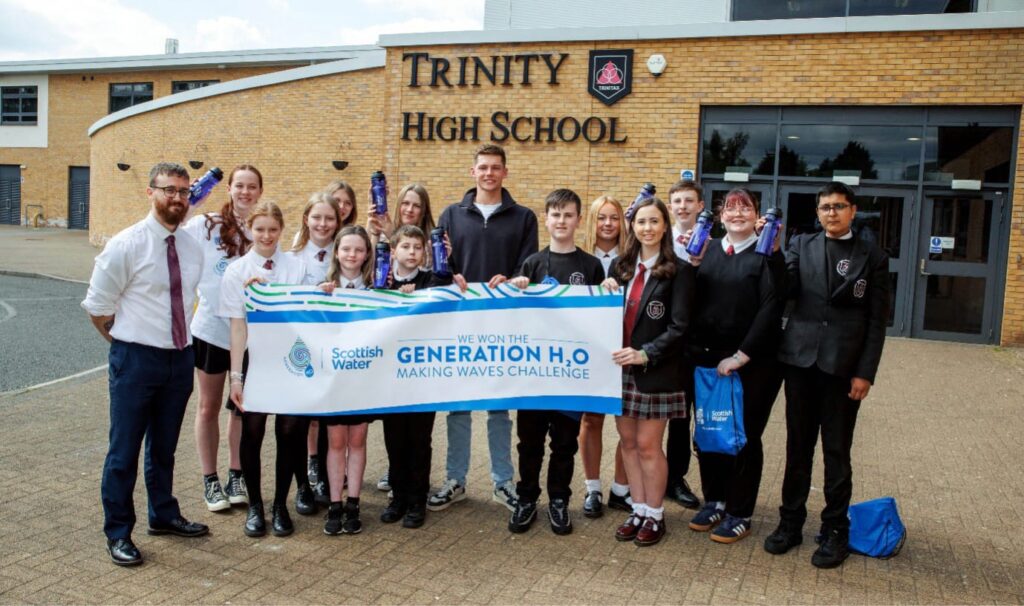
We have carried out engagement with stakeholders and local communities around our plans for woodland creation over the upcoming planting season which span sites across Scotland.
Repairing and maintaining treated Water Storage tanks in our networks across the whole of Scotland is responsible for c. 10% of the spend on our water treatment works and networks each year. Given the repeatability of site set up’s for this work MacKenzie Construction Limited (MCL) investigated the lowest carbon site set up.
Burghmuir treated water storage tank repair in Perth, had a 42 week work programme, MCL adopted – aluminium track panels for the access road, eco welfare units, hybrid power generator, HVO to replace diesel and used a hydrogen powered site security system.
By comparing a traditional site set up with the set up at Burghmuir, MCL achieved a 97% reduction in CO2e emissions saving 126 tCO2e and a £43k reduction in costs. 70% of the site establishment used hybrid power.
This set up is now BAU across our sites.
10 new electric vans have been delivered to Customer Water Services (CWS) and Electrical and Mechanical (E&M) operational teams in Orkney, across Westray, Sanday, Eday, North Ronaldsay and the Orkney Mainland. To support the transition, electric vehicle (EV) charging points have also been fitted at operational sites including Boardhouse Water Treatment Works (WTW) Kirkwall Waste Water Treatment Works (WWTW) and Bu-Point WWTW, with another 5 site installations in progress. All operatives are very pleased with the new EV driving experience and pioneering for the greener environment.

Scottish Water Horizons has delivered an innovative hydropower scheme at Hamilton waste water treatment works. This project signifies a significant leap forward for the industry, achieving several notably milestones. Firstly, it marks the UK’s first mid-process waste water installation which maximises energy potential. It is also Scotland’s first containerised hydropower installation, delivering dual benefits of reducing construction emissions whilst saving time and costs. This project reduces our reliance on imported grid electricity and minimises on-site energy expenses. The scheme is estimated to produce 0.42 GWh of green electricity annually, offsetting approximately 14% of the site’s yearly energy demand and mitigating around 64 tCO2e annually.
This year we achieved a key milestone for our plans to improve carbon capture and biodiversity at Loch Katrine, the source of water for Greater Glasgow. We have been working closely with Forestry and Land Scotland to prepare a 10-year land management plan for the 9500 ha estate around the loch and this has now been submitted to Scottish Forestry for approval.
The plan looks at how we increase tree cover and biodiversity and focuses on natural regeneration using Scottish native trees including birch, rowan, oak and alder. This approach has a minimal impact on the catchment and water quality. We will also be restoring peatland at the site.
The project is set to deliver a 40% increase in biodiversity on the estate and capture nearly a million tonnes of carbon over the next 60 years.
Scottish Water installs many glass reinforced plastic kiosks on its assets to house a wide variety of equipment- from chemical dosing skids to electrical panels. There is a high carbon content in the kiosk- often more than the equipment in the kiosk. Two of our construction partners have been exploring alternative low carbon materials. Three new kiosk types have now been designed and built with low carbon materials and we are starting to deploy them on projects. One is made from recycled plastic bottles, one is made from engineered timber and the third is made from light gauge steel. The carbon reduction ranges from 60 to 85%, depending on the material used and the security rating of the kiosk. As well as being used by Scottish Water, other utility companies are also looking to use them on their projects.
Scottish Water has established a framework for the supply of sustainably sourced hydrotreated vegetable oil that can be used by both Scottish Water and its construction partners. It’s a drop in fuel replacement that reduces emissions by 90% compared to conventional diesel.
Over the last year it has been widely adopted by our construction partners, displacing diesel use in excavators, cranes and other heavy plant. It is also being used to fuel generators to provide power for remote construction sites.
On our water mains rehabilitation programme its adoption is expected to reduce emissions by nearly 30%.
Scottish Water has been a partner in a project, led by the local community and supported by the National Lottery’s Community Fund, to regenerate the site once occupied by Douglas Primary School as a multi-functional greenspace.
Our team worked with the community to incorporate sustainable drainage features in the new park, which store and slowly release the rainwater that falls on surrounding roads and rooftops during storms. This eases pressure on the combined sewer network in the local area, as well as helping to protect the local environment and reduce flood risk from the Dighty Burn. Importantly, the community has been able to realise its wider aims by creating an attractive outdoor space that also provides a home for wildlife; and can be enjoyed for play, relaxation, exercise, events and the growing of food.
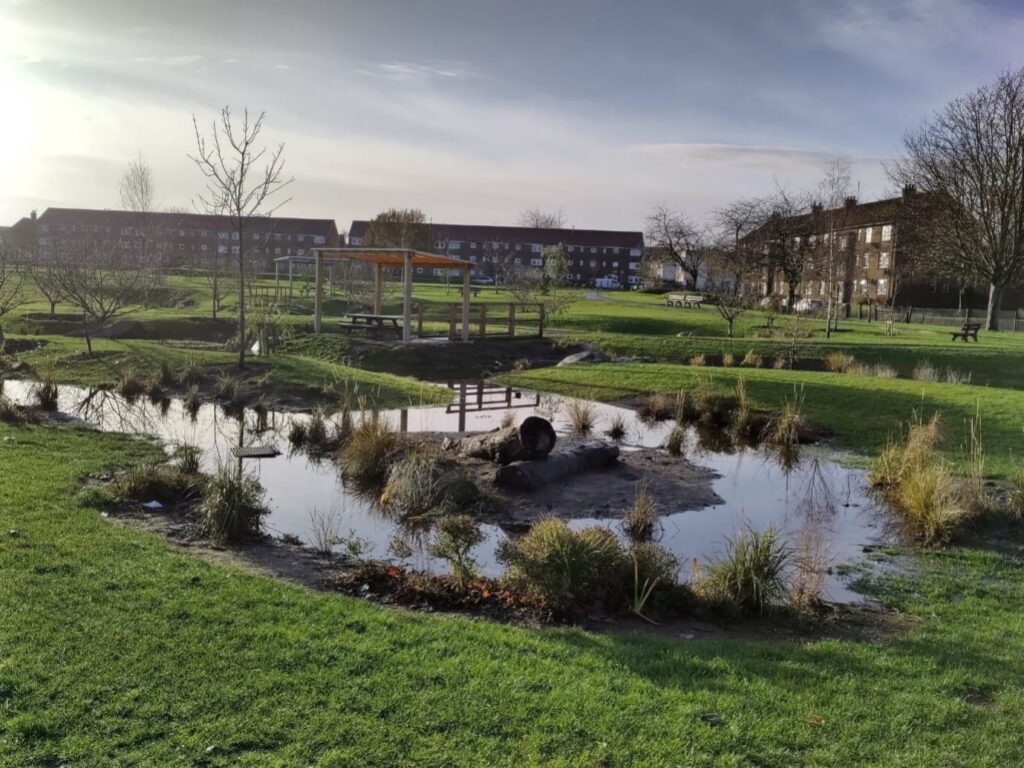
Planning is now underway to introduce more sustainable water management measures in the area surrounding the park, with the aim of disconnecting over 40,000m2 of land area from the combined sewer network; and helping to enable the development of more social housing in Douglas. Engagement with the community, including schools and other key stakeholders, is being carried out to help shape the proposals.
Work with the community and Dundee City Council on sustainable drainage for Douglas has helped to inspire the Water Resilient Dundee partnership. This initiative is now pursuing opportunities for more sustainable management of stormwater across the city, reducing flood risk in communities, creating capacity for development and enhancing amenity.